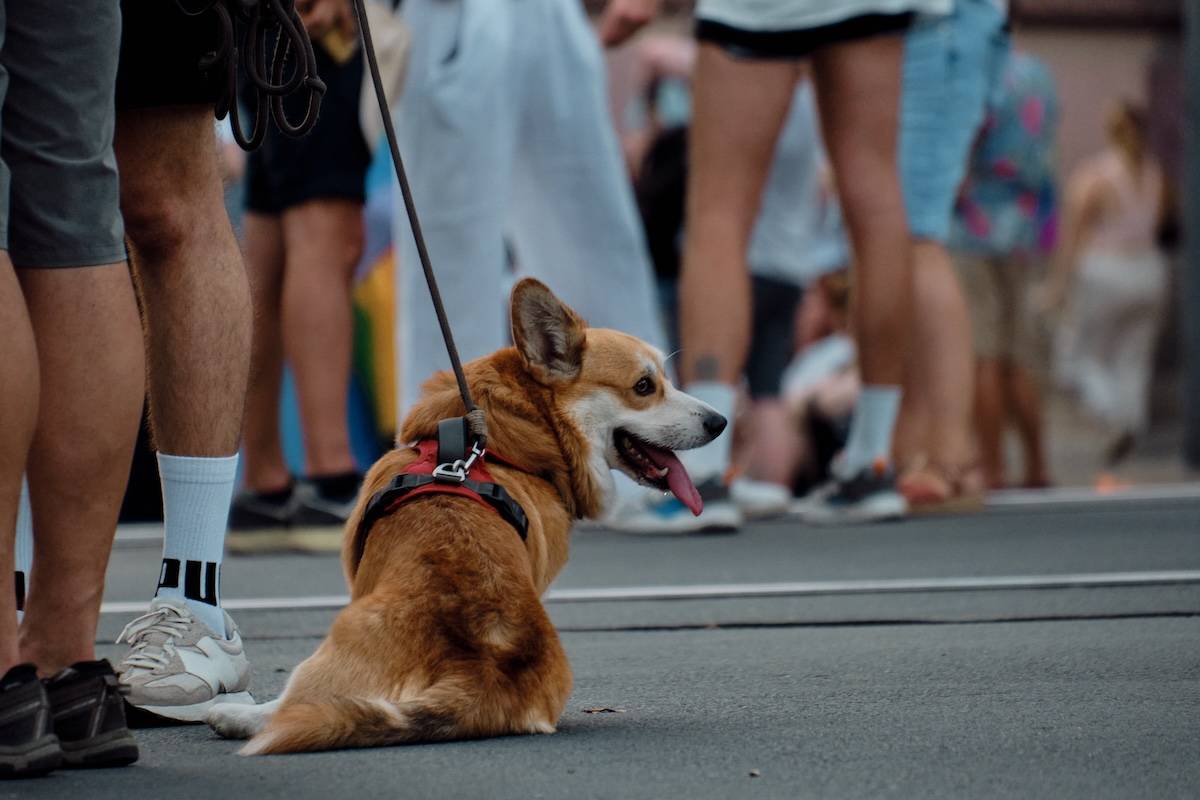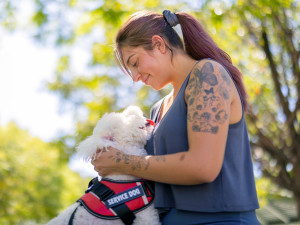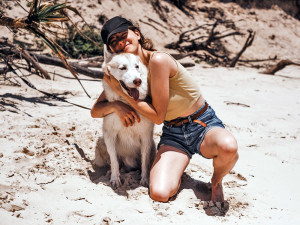Should You Take Your Dog to Protests?
Do the benefits outweigh the risks? Here’s all you need to know
In this article:
Risks for dog at protests Can some dogs handle a protest? Safe alternatives for activist dogs Safety tips for dogs at protests Should I take my dog to protests?
Our dogs might have questionable ethics when it comes to chasing wildlife, but it’d be nice to think they’re on the same page as us when it comes to political and social issues, right? Protesting is a powerful form of activism, putting pressure on those in charge to make positive change. But, while we all love getting our dogs involved in voting (dogs at polling stations anyone?), taking them to a protest could be a step too far.
It’s totally understandable that you’d want to bring your dog along – protests can be overwhelming, and it’d be lovely to have your bestie there for companionship and emotional support. Not to mention the fact that dogs draw attention, so they can help turn heads towards the cause. Plus, if you have a service dog, you quite literally need them there.
However, while you should absolutely exercise your right to protest, that sort of environment may not be ideal for your pooch. To help you make the best decision, let’s look into what your dog could be facing by attending a protest.
How much do you spend on your pet per year?
The risks of bringing dogs to protests
We’re not going to sugarcoat it – taking a dog to a protest is incredibly risky, especially if it’s a large-scale demonstration with counter-protestors that’s likely to get rowdy. Dog behaviourist, Lisa Sinnot, from St Paws Training Academyopens in new tab delivers the lowdown on the issues you could encounter by taking your dog along.
Noise
“Loud chanting, sirens, whistles or just amplified noise in general can distress dogs, leading to anxiety or fear-based aggression.”
Heat-stroke
“If you’re protesting in the summer, be aware that you’re unlikely to have many options to find shade, especially if it’s busy. Dogs don’t sweat like we do, and heat-stroke kills fast.”
Being trapped
“Riot police often use kettling as a way of controlling protestors (where they surround people to contain them in one area). Once enclosed, you won’t be able to leave to find water, shade or safety. Dogs who panic in confined spaces may become aggressive or injured.”
Dog bites
“If a dog reacts and bites amid chaos, you risk legal ramifications, as well as potential retaliation from frightened or hostile demonstrators.”
Missiles
“Objects thrown in anger or chaos – like bottles or rocks – can easily injure dogs.”
Crowd surging and crush injuries
“Sudden movements in a packed crowd can cause serious harm, especially to small or medium-sized dogs.”
Crowd dispersal
“In some protests, explosive devices are used to disperse crowds. Like fireworks, they can terrify dogs, triggering reactive behaviour.” Police may also use water cannons, rubber bullets or tear gas (CS gas), which can cause injury to both yourself and your dog.
Petrol bombs
“While rare, petrol bombs have previously been used [recently at protests in the US and the UKopens in new tab]. These obviously pose a significant injury risk for all concerned.”
Arrests
Arrests happen at protests and they happen fast. You’ve probably seen videos on social media of pensioners and people in wheelchairsopens in new tab being carried away – no-one is immune. If you get arrested, what happens to your dog? According to Surrey Policeopens in new tab, officers will ask you to nominate someone to collect your dog. If this isn’t possible, your dog will be placed in an approved kennel facility. The rules are different for assistance dogsopens in new tab, although be aware that while they might be allowed at the police station, they may not be allowed in the cell with you.
Lasting trauma
It’s also important to remember that the risks don’t end when you leave the protest – if your dog has a terrible time, you could face serious long-term consequences. “If dogs are traumatised, this can cause behaviour issues elsewhere,” warns Jeanette Muldoon, a dog trainer and behaviourist at Easy Peasy Puppy Trainingopens in new tab. “When dogs are scared, what they can see, smell and hear at that time can then become triggers for them in future situations.”
Reading your dog’s temperament
Before taking your dog to any new or unpredictable environment, it’s crucial to know what fear or stress looks like for them. “If you see your dog panting, whining, trembling or tucking their tail, it’s a sure sign they’re in distress, and you need to leave immediately,” warns Sinnott. Muldoon adds that while some dogs may bark, lunge or try to get away when scared, others may shut down, leaving some pet parents completely unaware that their dog’s even struggling.
Are there any types of dogs who might cope better at a protest? “Personally I wouldn’t take any dog to a protest as they’re often noisy, rowdy and you’re not able to see their body language at all times,” advises Muldoon. “However, some dogs are able to cope in crowds, happy to hang out and, are what we call ‘bomb-proof’(not easily frightened and able to calmly deal with new situations and stimuli), so a smaller protest in the country might be OK for these dogs.”
As for those who definitely shouldn’t attend? Muldoon warns that anxious or noise-sensitive dogs, and those who dislike being handled will likely struggle in a protest environment.
Alternatives for dog-loving activists
Don’t worry, there are plenty of ways you can still get your dog involved in your activism, even if they’re not present at a protest.
Donate
OK, so technically your dog’s not involved in this one unless you do it in their name. But, making a donation to a legitimate organisation that supports your chosen cause can be a surefire way of helping from afar.
Sponsored activities
Your dog loves walkies, right? A sponsored walk or run, or a hiking or training challenge could be a great way of raising money and awareness. Doing good while teaching an old dog new tricks? Yes please.
Online activism
While the long-term effectiveness of social media activismopens in new tab remains unclear, the Black Lives Matter and Me Too movements are two examples of campaigns that have successfully leveraged social media in recent years. Of course, neither have erased racism or sexual abuse (if only), but you can’t argue that they didn’t succeed in swiftly raising awareness. So, get your dog involved by posting a picture of them to promote the cause, or posting about the issue from your dog’s account (if they have one).
Allyship accessories
If your dog’s comfortable in clothes or accessories, why not pop a sticker on their rain jacket that displays support for the cause, or get them a collar or bandana in any colours or flag pattern that will signify solidarity. Ideally, look for products that donate the proceeds back to the cause. You never know what conversations could be sparked.
If you do bring your dog to a protest: safety tips
Still want to bring your dog along? OK, you’re going to need to do some careful planning to keep your dog safe. Here’s what we recommend.
Pack supplies
“Bring a first aid kit, poo bags, enough food or treats for the duration, a collapsible bowl and fresh water,” advises Sinnot. “Dogs dehydrate quickly under stress.”
Put an ID tag on your dog
Sinnot recommends putting an ID tag on your dog’s collar, and making sure their microchip details are up-to-date in case you get separated.
Consider protective gear
A high-vis collar, harness or jacket can help your dog stand out to prevent people tripping over or bumping into them. You can also buy protective dog vests, although if you think your dog will need one, you should seriously reconsider taking them.
Know your dog’s limits
“Walking on a lead at your pace for a period of time may be really hard for your dog, especially if it’s warm weather,” warns Muldoon. “Heat exhaustion can have tragic circumstances.” Early signs of heat stress include heavy panting, drooling, agitation and increased heart rate.
Plan exit routes
It’s wise to stay on the fringes of the crowd if you’re bringing your dog, but either way, make sure you know which way to head if your dog’s feeling stressed or tensions escalate.
Stay calm
“Dogs can smell when you’re stressed, so if you start feeling anxious, this will also worry your dog,” Muldoon advises.
Monitor social media
In the days leading up to the protest, keep an eye on socials. If police are ramping up their presence, or a small, peaceful protest looks like it’s turning into a huge affair with counter-protesters, we’d strongly advise you to leave your dog at home.
Dogs at protests: the bottom line
No two dogs are the same, just as no two protests are the same. We recognise that a small march in a rural town is a totally different ball game to a huge rally in a city, so it’s up to you to do your research and decide if your dog would be comfortable at a particular protest. If you have even an inkling of doubt though, please leave your dog at home and ensure they have someone who can take care of them if you get arrested – your dog’s welfare should always come first. Activism begins at home, after all.
References
“Dogs in Possession at Time of Arrest Procedureopens in new tab.” Surrey Police. Accessed 23 Oct. 2025.
Liberty. “What if I’m Detained or Arrested? Disabled People’s Rights - Liberty.opens in new tab” Liberty, 2 Jan. 2025.
Saunders, Ryan. “Is Digital Activism Effective? | University of Sussexopens in new tab.” University of Sussex - Study Online, June 2022.
Guardian staff reporter. “Petrol Bombs and Fireworks Launched at Police during Ballymena Rioting – Video.opens in new tab” The Guardian, The Guardian, 11 June 2025. Accessed 3 Nov. 2025.
Swallow, Bea. “Priest, 83, Arrested at Palestine Action Rally – on Day It Was Bannedopens in new tab.” BBC News, 7 July 2025.








